When we mention Tuscany we think of those immense meadows, with lavender, green and yellow colours, vineyards and small villages where you can get lost, in short, a place to disconnect. Fancy a trip to Tuscany?
But Tuscany is much more than that. This region of Italy, one of the 20 that make up this republic, is located in central Italy and its capital is Florence, in it we will be able to enjoy the art, history, gastronomy and its peculiar geography from the beginning to the end of the trip.
For that reason, and because there is so much to see, we propose a tour of 12 places that we can not miss if we travel to Tuscany. A walk that will take us from Florence to the island of Elba, passing through Pisa, Siena or San Gimignano.
How to get to Tuscany?
The privileged location of Tuscany means that we can reach our destination by road, plane, train or boat. Obviously, the easiest way is to fly by plane and rent a car because, if we really want to get lost in Tuscany and explore its corners, the car will be our best ally.
By plane we will land at Amerigo Vespucci in Florence or Galileo Galilei in Pisa. There are many airlines that have direct flights here and from many places of our geography, besides Madrid and Barcelona, Bilbao, Malaga or Seville also offer this possibility.
Here we go!
By car it will take from Madrid, for example, about 22 hours making turns, so this idea is almost discarded if we do not have many days to take advantage of the visit to Tuscany, not in vain are more than 1,600 kilometers from the capital and just over 1,000 from Barcelona.
What is highly recommended is to rent a car at the airport, or bring it already rented from Spain, and take one of the three highways (A-1 Milan-Napoli; A-11 Florence-Sea; and A-12 Genoa-Livorno) that will take us through the route we have planned.
If we choose the train or the bus, we have to know that there is no possibility to travel direct from Spain. What we can do is to find out here about the different trains and buses that will take us to the places we choose on our route.
The last options are to arrive by sea, by ferry to the port of Livorno, which connects with some of the most important Spanish ports such as Barcelona or Valencia, or by cruise, whose departures are from Barcelona, Valencia and Malaga. Here we leave you a link to find the ferry or cruise that best suits your planning.
Top 10 must-see places on the Tuscany Route
-
Florence
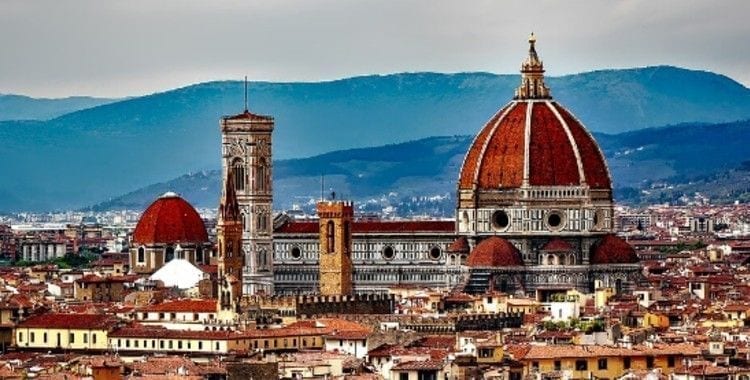
This open-air museum is the capital of Tuscany. Florence is a city that envelops you from minute one, you can breathe history, art, mystery… in each of its corners.
A visit to Piazza del Duomo is a must, where the Florentine Cathedral, Giotto’s Campanile and the Battistero di San Giovanni give us the first photo of our trip. Another visit is to Piazza della Signoria where the Palazzo Vecchio and the Loggia dei Lanzi museum await us.
Ponte Vecchio
Of course, we won’t miss the Ponte Vecchio, the oldest bridge still standing in Europe, which is crossed by the Arno River. There we will take the opportunity to leave a padlock as a symbol of eternal love.
The Santa Croce, the church of Santa Maria Novella, the Piazza de Michelangelo, the Medici Chapels built by Brunelleschi, or the Boboli gardens behind the Palazzo Pitti are other places not to be missed. In this garden we can rest and admire marble sculptures, an Egyptian obelisk or the fountain of Neptune. It can be visited from Monday to Sunday from 8:15 to 16:30 from February to November, from 8:15 to 19:30 in June, July and August, in March from 8:15 to 17:30 and in April, May and September until 18:30. It closes on the first and last Monday of each month and the entrance for adults costs 7 euros, for young people from 18 to 25 years old 3,50 euros and for those under 17 years old they are free.
In the Museo dell’Opera del Duomo, which in its beginnings was a workshop for the artists of the time, we will find works by Brunelleschi, Donatello (Mary Magdalene) or Michelangelo (Bandini’s Pietà), who made here his famous ‘David’ which, however, is on display in the Accademia Gallery, another must-see.
-
Pisa
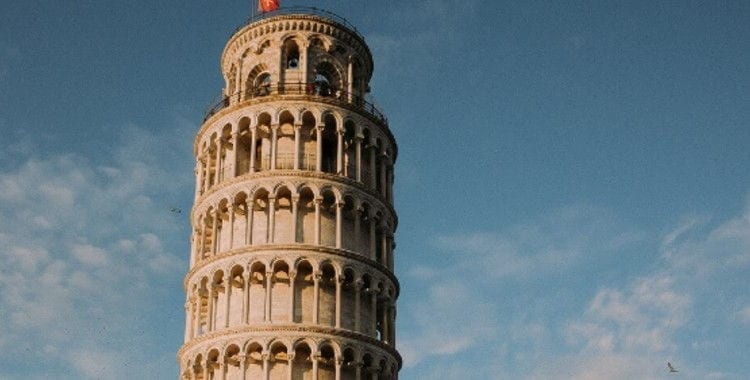
It is inevitable that when we name Pisa, the first thing that comes to mind is its famous leaning tower. Obviously, it will be the first thing we see but this city has much more to offer.
In Piazza dei Miracoli, we will find three exceptional monuments, the Leaning Tower of Pisa, not forgetting that this is the bell tower of our second stop, the Cathedral, to close with a visit to the Baptistery.
Let’s start by talking about the Tower of Pisa, a 12th century monument that, thanks to the limited expertise of its architects, became one of the most visited monuments in the world. We can not fail to make the typical photo with the tower and visit inside. The entrance fee is 18 euros, we recommend that you book in advance because on long weekends, summer and other holidays, it can take up to three hours to get in. Visiting hours are June, July and August from 8:30 am to 10 pm; in April, May and September from 9 am to 8 pm; in March from 9 am to 6 pm, in October from 9 am to 7 pm, in November and February from 9:40 am to 5:40 pm, and in December and January from 10 am to 5 pm.
The Battistery
The Duomo di Pisa, or the Cathedral, began its construction in 1064 and was consecrated in 1118. It houses the Museo dell’Opera del Duomo where you can see paintings, liturgical objects and sculptures.
The Battistero di Pisa or Baptistery is the largest in Italy, 55 meters high and 34 meters in diameter. Built in marble, its construction began in 1152 and was completed in 1363 and being built on the same ground as the Tower, it is also inclined. The octagonal baptismal font inside is well worth a visit.
In addition to these three jewels, we can visit the church of Santa Maria della Spina; the Ponte di Mezzo or Middle Bridge; the Museo delle Sinopie, where we will see sinopie, drawings from the Middle Ages made on parchment or paper that have survived until today; Piazza dei Cavalieri, the second most important square in the city, has as its main building the Palazzo della Corovana; and the Museo di San Matteo, where you will see works from the 12th to the 17th century and archaeological remains that make it one of the most representative museums of European medieval art.
We finish the visit knowing the Palazzo Blu or Blue Palace, in the center of the city, and the neighborhood of Santa Maria, where we can get lost in its streets and discover more of the architecture of this beautiful city, once a maritime power and today a source of culture.
-
San Gimignano

This beautiful medieval village leaves us one of the most beautiful postcards of Tuscany. The vineyards surrounding the walls with two of the thirteen towers still standing, rising above everything else, make a visit to San Gimignano take us back to another era, to more than 900 years ago, when the town was at its peak of splendour.
San Gimignano, whose visit should be done outside the ‘high’ season (summer and long weekends) to avoid overcrowding, is directly linked to its wines, so that tasting the Thegreat white Vernaccia wines of the area are not to be missed, as well as a visit to the museum dedicated to this wine.
La Cisterna Square
We start the visit at Porta San Giovanni to follow the street to Piazza della Cisterna where the most important buildings of the town, which today has about 8,000 inhabitants, are located. Here we find several Palazzos, Tortoli, del Podestà, Ridolfi or Lupi, with the Devil’s tower, and the Arco dei Becci. Here we must stop at Gelateria Dondoli, the best gelateria in the world, as it has been awarded numerous times.
Nearby is the collegiate church of Santa Maria Assunta whose frescoes will surprise you. We cannot forget its towers. In its heyday it had more than 70, today there are 13 left, and it is these that give it a unique profile more typical of a 21st century city than of the Middle Ages. The Torre Grossa, the highest at 54 meters, from where we will be treated to a spectacular view, and the Torre Rognosa, the oldest, are two of the ones we will be able to see.
-
Siena
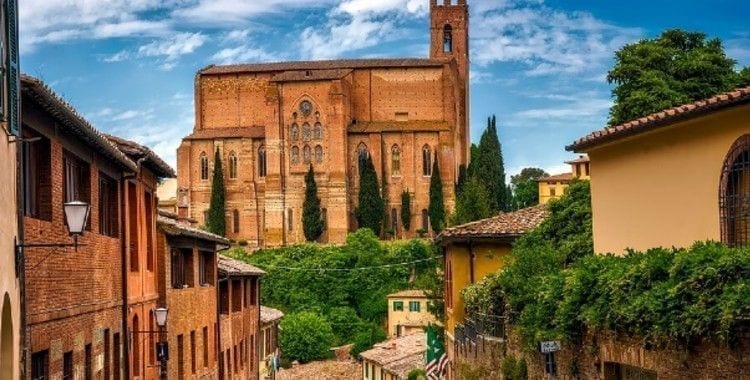
The Palio of Siena is the most famous tourist attraction of this beautiful and amazing Tuscan city. This horse race, which pits different districts of Siena against each other, is held on 2 July and 16 August in honour of the Madonna of Provenzano and the Assumption of the Virgin, respectively. But Siena is much more.
Born in Etruscan times around 900 B.C., it reached its peak in the 12th and 13th centuries thanks to the Romans. Siena is a city that captivates from the first moment. Our visit starts at the church of San Domenico, in a surprisingly sober Gothic style. We will enter via Bianchi di Sopra and via della Citta, the two main streets of Siena, where tourism, commerce and architecture come together.
The places
One of the first squares you will see is called Salimbeni, where the palace of the same name is located, although the most important is Piazza del Campo. Here you will be overwhelmed by its architecture, it is monumental, unique, one of the most beautiful you will see in the world. It is also the place where the Palio festival takes place and we can imagine the horses making the ground rumble, a great spectacle.
Here we find the Tower of Mangia, 102 meters high, the Palazzo Pubblico, seat of the town hall. If you dare, climb the 505 steps of the tower to enjoy the panoramic view of Siena.
In Piazza del Duomo you can visit the Baptistery of St. John where the richness and details of the baptismal font or the Feast of Herod by Donatelloleave the visitor speechless for its beauty. In the Duomo don’t miss the Opera Museum and the Panorama, a viewpoint that will give you another unforgettable panoramic view of Siena.
-
Chianti Region
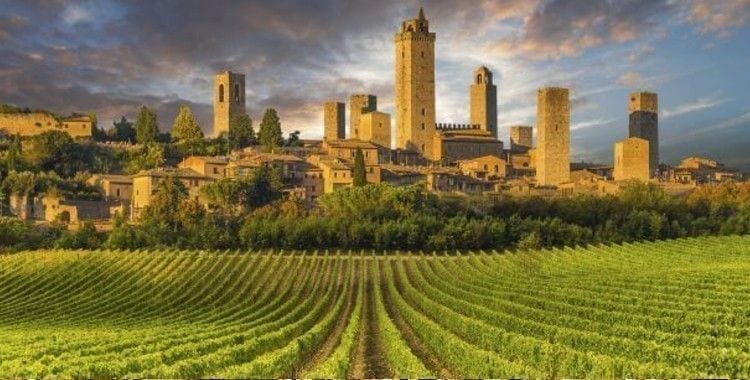
Wine lovers should not miss a visit to this group of villages where castles and wineries, with the Gallo Nero brand, symbol of the authentic Chianti, offer dreamlike landscapes.
This valley, where the vines will accompany us all the way, is full of endless forests with holm oaks, oaks or chestnut trees, with multicolored flowers and beautiful and unique medieval villages.
Greve in Chianti, with a peculiar triangular square; Radda in Chianti where we can see the Palazzo del Podestà and the old castle; Castellina in Chianti which is crossed by the via delle Volte; Gaiole in Chianti where we will find the castles of Fonterutoli and San Leonino; or Montefiorale where, very close, we will see the abbey of Passignano, are just some examples of what we will find in this beautiful area.
-
Colle di Val d’Elsa
This small town, divided into two areas, Colle Alta and Colle Basso, is known as the ‘Bohemia of Italy’, as it is home to the major producers of the glass industry.
In this beautiful city we can visit the Duomo, with the impressive clock tower, the main Piazza Arnolfo, where on Fridays we can visit a market, the Palazzo dei Priori where we will visit the Museum of Sacred and Civic Art, the former conservatory of San Pietro del Vasario, the Ranuccio Bianchi Bandinelli museum and, of course, the Museum of Glass.
-
Val d’Orcia
This Orcia Valley is a UNESCO World Heritage Site. With this letter of introduction we can imagine the beauty of this area in which the landscape, shaped by the years, and the buildings, form a perfectly integrated whole. It is the typical Tuscan picture, it is the essence of our trip.
Some of the villages we can visit are Montalcino, Pienza, San Quirico, Castiglione d’Orcia or Radicofani, although the ideal is to look at a map of the area and make our own route. And in all of them, wines and gastronomy, with cheeses, mushrooms, truffles, pasta, sausages or organic olive oil as absolute protagonists.
Olive trees, vineyards, cypresses, chestnut trees… are our travelling companions giving us the peace and calm that made Val d’Orcia a landscape reference in Renaissance times. Harmony is what defines this walk that we recommend to do it by car to stop in every corner and get lost in these special ecosystems.
-
Terma Libere di San Filippo and Terma of Saturnia
In Val d’Orcia these thermal baths are very close to each other. The first, the di Dan Filippo is one of the most curious of Tuscany for its limestone formations, the result of the warm sulphurous thermal waters that have given relief to many visitors since the Middle Ages.
It is advisable not to go on weekends or in times like summer or long weekends, as we will find many people. In them we can treat skin, lung and joint problems… as well as enjoying a therapeutic mud wrap and the warmth of the hot springs.
The Satunia Therma, with water at 37 degrees all year round, originates from the Gorello stream on Mount Amiata. There we will find the Gorello and Molino waterfalls as part of a unique landscape that the waters have shaped over the years. Two options for relaxation, very much to be considered on this trip to Tuscany.
-
Pitigliano, Sorano and Sovana
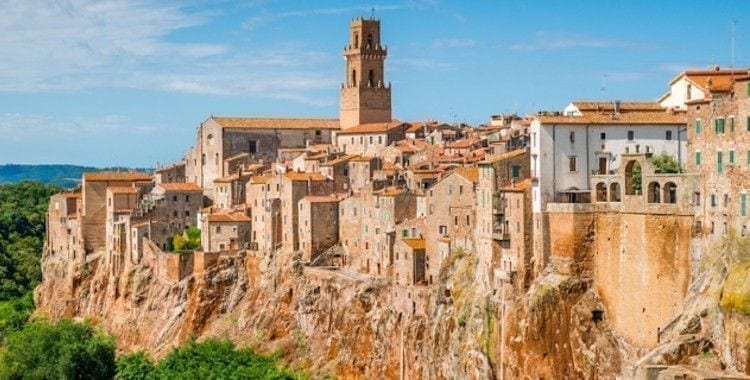
These three villages, Pitigliano, Sorano and Sovana, located very close to each other, are in the Maremma area, and are a very interesting visit to one of the least explored areas of Tuscany.
Pitigliano
The best known, Pitigliano, is called ‘Little Jerusalem’, due to the large number of Jews who lived there in the 19th century. Here we can admire Piazza Petruccioli, the entrance to the historic centre, where we find the Palazzo Orsini which houses the Archaeological Museum, the diocesan archive and the library, as well as a courtyard and a hexagonal well that are very curious.
The 11th century Medicean aqueduct with 15 arches points the way to the Orsini Fortress. We continue the tour until we reach the Duomo of San Pietro e Paolo located in Piazza Gregorio VII, with a bell tower that stands out from the rest.
In the Jewish quarter we will visit the Synagogue and the caves of Vie Cave di Pitigliano, where we will discover the history of the caves excavated by the Etruscans.
Sorano.
This is our next stop, a peculiar town of Etruscan origin on the banks of the river Lente. Military architecture in its purest form, we enter through the Porta di Sopra to find the 14th century Cathedral. We must not forget to visit the archaeological park, with cave architecture to admire and tombs that we will find fascinating.
Sovana.
It is the third stop of the so-called Cities of volcanic tuff or Città del Tufo.The necropolis, where the spectacular tombs, such as the Tomba Ildebranda, the largest found to date, which the Etruscans dug into the rocks, will leave you speechless; the cave settlement of Vitozza and the cave complex of San Rocco, are two must-sees for their incalculable historical value; and the Orsini Castle Museum, with a unique collection of ceramics from the area from the Middle Ages and the Renaissance.
-
Volterra
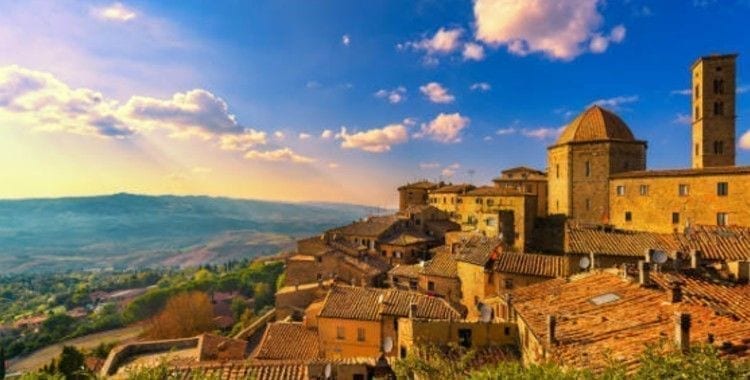
A city of reference in Tuscany, Volterra is a unique place where we will enjoy Etruscan, Roman and Medieval architecture. It is fantastic to get lost in its streets and enjoy every corner where you can breathe history.
The entry
To enter this village we will have to climb a steep slope because, as a curiosity, is located more than 500 meters above sea level and immediately we will have before our eyes the Palazzo dei Priori, the oldest palace in Tuscany and the inspiration for the construction of the Palazzo Vecchio in Florence.
The access gates to the city, the San Francesco and Florentine gates, are perfectly preserved, as is the 12th century city wall, which retains the charm of the days when it protected Volterra.
In Piazza San Giovanni we find the Cathedral of the Assumption and the Baptistery, octagonal in shape and dating from the twelfth century. Here there is a viewpoint from which you can see a good part of the landscape surrounding this emblematic city.
In the Enrico Fiumi Archaeological Park, located in Piazza Martiri della Livertà, we will see the remains of the Etruscan acropolis and the Roman remains. In the background you can see the fortification, one of many that the Medici built to safeguard their properties and territories.
We can’t miss the Roman Theatre located outside the walls and finish the visit entering Volterra to delight us with the Etruscan Museum Guarnacci, the Civic Museum and the Alabaster Museum.
Recommendations for visiting Tuscany
- Find out about opening times and ticket sales or reservations for the most popular monuments, especially if you are travelling at peak times.
- Take time in each city to discover every corner, talk to the locals and get to know the ‘other’ stories they may know.
- There are many restaurants where you can eat well and for little money. You will find them walking the streets of towns and cities.
- Plan your route in advance to see each place perfectly and not go on the run.
- If you have time, visit the island of Elba, a cultural and biological paradise that is part of Tuscany and is well worth a visit.
- If you are going to rent a car, which is highly recommended, compare prices and do it from Spain in advance to avoid surprises.
- Look for rustic accommodations, they have a lot of charm and many of them are great value for money.
- Wear comfortable clothes and appropriate footwear because many cities have steep or stony streets and you’d better be well prepared.
- Mid-spring is when the vines begin to bloom, it can be a good time to visit the areas of Tuscany that are surrounded by vineyards and enjoy the scenery.
- Be patient, enjoy and soak up the history, culture, landscapes, gastronomy, winemaking… this trip is for the senses, don’t be in a hurry.















Leave A Comment